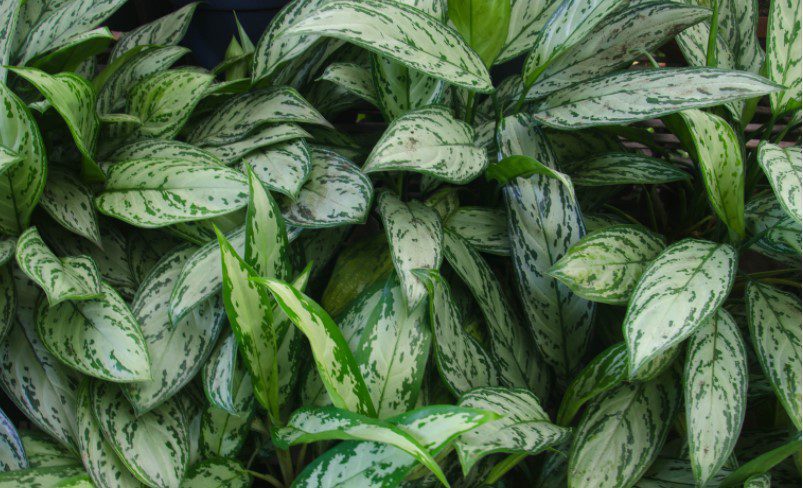Chinese evergreens
Chinese evergreens (Aglaonema) have been a staple of my interior landscape for more than 25 years, and I continue to appreciate these wonderfully versatile plants. They are one of the easiest plants to grow indoors yet pack a punch in terms of their impact in any indoor environment.
Because I have had these plants in my collection for so long, I often take them for granted and really do not think much about how valuable they are.
Chinese evergreens are not inexpensive plants; I started with one plant, and over the years, I have started new plants to the point where I now have about half a dozen sitting around the house.
Aglaonema is easy to slip — 30-centimeter lengths of stems (the tops) will readily root in water, although it might take a couple of months.
Growing Chinese Evergreens Indoors
One of the great attributes of Chinese evergreens is that they are incredibly slow-growing, so you do not have to be constantly re-potting, dividing, and slipping. Eventually, however, the plants do get leggy, and the time comes to cut them back — I do this about every two years.
I cut the stalks back to about 10 centimeters; new stems will emerge from around these cut-off stalks to establish bushy new plants. In the meantime, I cut the tops of the stems off to a length of about 30 centimeters and put these stems into a large vase of water.
I keep the vase in bright light and the water in the vase topped up. I usually undertake this job in early summer, right after the rush of the outdoor planting season is over.

I think the slips root better at that time of year, and the cut-off plants develop new growth more quickly during the summer than they would during the winter. When the slips have developed their thick, fleshy white roots, I plant about eight of them into a 10 inch or larger pot.
Chinese evergreens are big plants that are best displayed as floor plants, so I use large pots to fit the large jardinières that I keep around just for them. The leaves get dusty over time, so I wipe them periodically with a soft, damp cloth.
Chinese Evergreen Care Tips
Aglaonema like well-drained soil and moderate moisture — don’t keep them wet. On the other hand, don’t let the soil completely dry out, or the tips of the leaves may turn brown. I have never had insects on my Chinese evergreens and no disease problems either.
Because they are slow-growing plants, they require little fertilizer — maybe a couple of applications of a weak 20-20-20 soluble fertilizer in the summer.
Chinese evergreens tolerate a range of temperatures and light levels. The plants will get leggy a little more quickly if they are located in deficient light levels, but I have a couple of plants that continue to look attractive, and they are on the far side of the living room from a north-facing window.
As the common name Chinese evergreen implies, the plant originates in tropical and semi-tropical Asia. It is also a member of the group of plants known to clean the air of impurities, so we often see Chinese evergreens used in office buildings and apartment lobbies.
I am excited about the new varieties of Chinese evergreen that I discovered at the garden center. I hope I get there to select a specimen or two to enhance my interior landscape while there are some left!
Buying Chinese Evergreen
Buying a houseplant is like purchasing a new pair of shoes. It’s fun to look at the latest fashion, but we usually return to the familiar and comfortable style we’ve worn for years. “Smart and dependable” wins out every time.
For houseplants, Chinese evergreens (Aglaonema sp.) fill the bill. They look great with everything and never seem to wear out.
But, with the new varieties of Chinese evergreens being introduced, this dependable houseplant now has a fresh, stylish look. Queen of Siam and Rembrandt are two selections whose very names speak of something more daring.
Queen of Siam has elongated leaves with dark green edges and a cool green interior. The leaves are held above the base on regal white stems. This plant grows upright and, as it matures, may get fairly tall up to 24 inches.
Rembrandt’s artistry is apparent in its large dark green leaves striped and splashed with yellow. The leaves are held high on pale pink stems. Rembrandt will grow full and bushy, with plenty of pink stem showing through.
Chinese evergreens are available in various sizes, and their minimal care makes them attractive to use as accents in any number of ways.
A large plant in a 10- or 12-inch pot, such as the Painted Princess, will give life to a dark corner.
A 6-inch pot is suitable to use on a tabletop or bookshelf. Its low light requirement allows it to be used where few others will grow.
Even though the names of these new plants sound exotic, the care is easy as ever. Chinese evergreens grow best in medium to low light.
They do not tolerate direct sunlight. Water only when dry. Fertilize Chinese evergreens once a month using water-soluble all-purpose plant food.
During the winter months, do not feed at all. This Plant is one of the smartest and most dependable houseplants to grow.


























